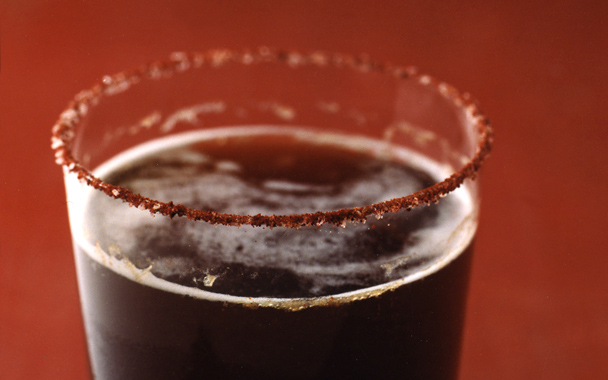I had my first Michelada one sweltering evening seven or eight years ago at the bar at Gaido's Famous Seafood Restaurant in Galveston, Texas. My Texan girlfriend and I sat down there to wait for a table at this always-bustling establishment and had just started to discuss whether to kick-start the evening by ordering Margaritas or something else similarly potent or just to ease into the proceedings by taking a chance on the restaurant's wine-by-the-glass selection. Then we noticed the couple next to us sipping something tall, cool, and amber hued from salt-rimmed, lime-garnished glasses. It looked awfully inviting. "What're y'all drinkin'?" my girlfriend inquired. "Micheladas," they replied. "We discovered them last year in San Miguel de Allende."
The Michelada, we learned, was nothing more than Mexican beer poured into a tall, ice-filled glass (its rim salted Margarita-style) with fresh lime juice and a bit of hot sauce (Tabasco, in this case) and Worcestershire sauce stirred in. We ordered a couple of our own and became instant converts. The lime juice etched an acidic edge across the flowery sweetness of the malt, the hint of faintly meaty Worcestershire offset the light bitterness of the hops, and the salt and hot sauce seemed to brighten the other flavors. If there was anything better on a hot Texas night than an ice-cold Mexican beer, we decided, it was a Michelada.
The Michelada is an example of what in Spanish is called a cerveza preparada, or gussied-up beer. (I translate loosely.) One curious example of the genre found in some parts of Mexico is a mixture, usually half and half, of beer and tomato juice. The Canadians, who also like it, call this red beer; I call it grimace inducing. The Michelada on the other hand, is delicious, refreshing, exciting.
The recipe accompanying this piece will produce a perfectly credible version of the drink. However, there are variations aplenty. When I make Micheladas, for instance, I omit the chile powder on the rim, use key limes (the juice of two to four of them, depending on size and juiciness), reduce the amount of Worcestershire to a dash, and double the hot sauce (I prefer Chilula, the fiery but flavorful chile pequín-based potion made near Guadalajara). Oh, and I always use light beer—preferably Tecate—because that's the way I first encountered the Michelada and the way I think it works best.
Other folks make theirs with nothing more than lime juice and salt. Some put the salt in the Michelada (this makes the beer foam more enthusiastically), and some add pepper, too. Soy sauce or Maggi (a soy-like vegetable-based flavoring) is sometimes used instead of Worcestershire. Lemon juice has been known to replace lime juice (it doesn't have the same effect at all). I've even heard that there are people who add tomato juice. Probably Canadians.
Most sources date the invention of the Michelada to the 1940s or early '50s; this makes sense, because ice cubes are unlikely to have been common in Mexico much before then. There are two widely disseminated stories about the origin of the name. One has it that the Michelada was invented by a man named Michel Esper at the Club Deportivo Potosino in the town of San Luís Potosí, in east-central Mexico; the other claims that it was christened in honor of a Mexican general, Augusto Michel, also of San Luís Potosí who reportedly liked to spike his lager with chiles and lime juice. The first story seems doubtful: If we know the name of the man who supposedly created it (for what it's worth, Esper is a common Syrian or Lebanese name; the French surname suggests the latter) and the site of its creation, it's curious that no further details have ever been presented. (We know chapter and verse, for instance, on the invention of two other Mexican classics, nachos and the Caesar salad.) As for General Michel, one Santiago Clariond—whose company makes a lime—and-salt-based product called MicheMix, to be used in the concoction of the Michelada—confessed to Will Weissert of the Associated Press a couple of years ago that he'd made up that tale. "I thought a story would add mystique to our product," he said.
The most likely derivation? Chela is Latin-American slang for a blond, blue-eyed woman (what in Spain used to be called a sueca, a Swedish woman, regardless of her place of origin), and by extension became a synonym for light beer—much as in France, drinkers who want a lager-style brew will specify "une blonde," while those who want a dark beer ask for "une brune," a brunette. Chelada is thus quite likely a contraction of chela helada, meaning "iced beer." Mi is simply the possessive, as in "Hey, that's my iced beer, hombre."
Just to make things confusing, though, some Mexicans order beer on ice with lime juice and hot sauce added and call it a Cubana. Nobody knows why.



 Pinterest
Pinterest


